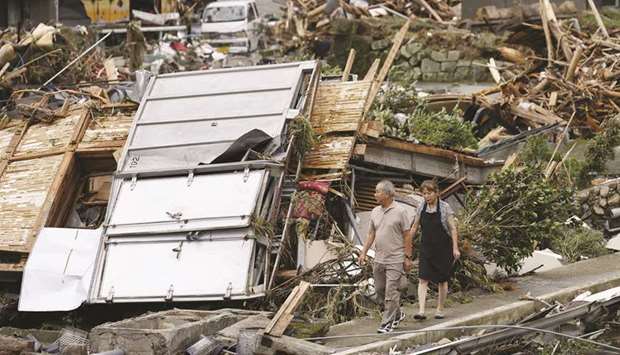Driving rain hampered the efforts of tens of thousands of rescue workers in southwestern Japan yesterday as they searched for survivors from deadly floods and landslides, with more torrential downpours forecast.
Around 50 people were feared dead after heavy rain lashed areas of western Japan beginning early Saturday, causing rivers to burst their banks and flood low-lying regions.
Bad weather was preventing some rescue efforts, local officials said, with at least 13 people still unaccounted for. “Because of the heavy rain, we were forced to cancel some emergency flights of helicopters over the disaster zone,” Tsubasa Miyamoto, an official from the Kumamoto region, told AFP.
Although the rain has eased from its peak, the floods washed away roads and bridges, leaving many in isolated communities cut off.
A local firefighter in the western region of Kagoshima told AFP they had deployed boats to rescue 11 people, but conditions were making it hard to reach others stranded. “Calls came from people telling us that they wanted to flee their home but they could not do it on their own,” he said. “Some roads are submerged and you cannot drive through them.”
In one of the hardest-hit areas, residents wrote out the words “rice, water, SOS” on the ground, while others waved towels and called for rescue and relief goods. At a nursing home for the elderly, 14 people were feared dead when water from a nearby river inundated the ground floor, leaving those in wheelchairs unable to reach higher ground. Emergency services, aided by locals in rafts, managed to rescue around 50 staff and residents from the facility, bringing them to safety by boat.
Heavy rain is expected to continue through today and the Japan Meteorological Agency issued a non-compulsory evacuation order for around half a million people in southwestern Japan. Up to 250mm of rain is expected in the 24-hour period through Tuesday morning in the southern part of Kyushu Island, which includes areas already hit hard by the flooding, the agency said.
“It’s such a mess,” resident Hirotoshi Nishi told public broadcaster NHK as he swept debris from his mud-strewn front room. “Many pieces of wood came into my house. I don’t know what to do.” Hirokazu Kosaki, a 75-year-old bus driver in the town of Ashikita, told Jiji press: “It was nothing but water as far as I could see.”
Evacuation efforts are also being hampered by fears of spreading the coronavirus that has claimed almost 1,000 victims in Japan, with close to 20,000 cases. Partitions have been set up at evacuation centres to keep distance between families and evacuees are made to wash their hands frequently, sanitise and wear face masks. For some local business owners already battered by coronavirus, the natural disaster has compounded their problems. Yuji Hashimoto, who runs a tourism bureau in the hot-spring resort in Yatsushiro, one of the flood-hit cities in Kumamoto, told AFP that the “beautiful tourism spot dramatically changed overnight.”
“The damage was beyond our imagination. It’s literally a bolt from the blue... The disaster is a double-whammy as our hot spring resort was struggling to weather the impact of coronavirus. We don’t know what will happen to us next,” he said. Government spokesman Yoshihide Suga told reporters that 19 people had been confirmed dead from the floods while a further six were in a state of “cardio-respiratory arrest” – a term often used in Japan before a doctor officially certifies death.
Suga said officials were investigating another 24 deaths to confirm a direct link to the floods. He said more than 40,000 personnel from police and fire departments, the coast guard and Self-Defense troops were conducting search and rescue operations throughout the night. Around 800 people had been rescued, Suga said, adding that 4,600 households were still without power and 7,000 without water.
Japan is currently in the middle of its annual rainy season which frequently delivers deadly floods and landslides. Climate change is also playing a role because a warmer atmosphere holds more water, increasing the risk and intensity of flooding from extreme rainfall. In 2018, more than 200 people died in devastating floods in the same region of Japan.

A couple looks around a site of their parent’s house which was damaged by torrential rain in Kuma town, Kumamoto Prefecture, southwestern Japan, yesterday.


